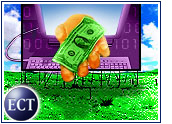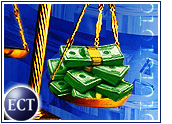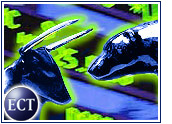
During these tumultuous economic times, even valuable companies show such weak revenues that the whole concept of valuing a company based on multiples of earnings may be fundamentally flawed. But it is still possible for a potential buyer or seller to place a price tag on a tech-sector company. It just takes a little work and a shrewd eye.
“Earnings multiples can be dangerous to use in manyareas of tech, because the only way to evaluate them is bycomparison with other companies in the same industry,” Morningstar.com analyst David Kathman told the E-Commerce Times.
While he noted that those comparisons represent “a reasonable thing to do in a relatively stable industry, such as food or retailing, it doesn’t do you much good when an entire industry collapses, as the telecom industry has over the past couple of years.”
Quick Change
Kathman explained that “the value of a stock, at least in theory, is thepresent value of the future cash flows it’s expected to generate,and predicting those cash flows can be notoriously difficult because technology changes so rapidly.”
In retrospect, he added, all telecom stocks were vastly overpriced a couple of years ago. “Whether you think they’re cheap or expensive now depends on how fast and how strongly you think they’ll recover, which nobody knows with any kind of certainty.”
Let the Buyer Beware
Indeed, most tech companies are not selling for the premium prices that characterized the dot-com era.
Recently, for example, IBM agreed to pay US$3.5 billion for PricewaterhouseCoopers Consulting, a lot of money in a sagging economy but practically a fire-sale price compared with the $18 billion Hewlett-Packard offered for PwC Consulting in 2000.
Giga Information Group analyst Pascal Matzke told the E-Commerce Times that it is unfair to compare today’s purchase price with one proposed two years ago when market conditions were different. Still, with such drastic shifts in price over the past two years, interested buyers and sellers must find some way to evaluate companies.
“It’s possible to put a fair valuation on a tech company, but it’s harder than putting a value on most non-tech companies,” Kathman said.
Finding the Right Price
One way is “to look at the bottom line” when a company is a public one, Giga analyst Andrew Bartels told the E-Commerce Times, or to gain a clear view of what types of products are selling well.
At Morningstar, one method used to value companies is a discounted cash flow (DCF) model. Using this model, analysts “explicitly predict what the company’s future cash flows will be, and discount them back to the present using an appropriate discount rate,” according to Kathman.
The model lets interested parties determine which assumptions are necessary to justify a given stock price. “I like using DCF models, because they give me something concrete to look at when coming up with a valuation,” Kathman noted.
It takes “a lot of experience” and “more than a little intuition” to use the model effectively, he explained. And it is not perfect. “It requires you to input a whole bunch of variables, some of which may be hard to predict.” Still, buyers and sellers must take their best guess — and thenface the added challenge of wondering how the effects of too-prevalent scandal could influence a company’s overall worth.















































One needs to be careful not to confuse ‘value’
with purchase price. As many readers probably have already noted, the purchase price paid by many companies for their late ’90s acquisitions during the ‘internet craze’ was
by no means reflective of the value of the company. Ask AOL Time Warner, or JDS Uniphase, or any of the other tens if not hundreds of other companies that have had to take $ba-$billions of write-downs for the disparity between purchase price and value.
Analyst Pascal Matzke claims it’s unfair to compare, he’s full of dust. Of course it’s fair.
"Those who do not learn the lessons of history are doomed to repeat it."